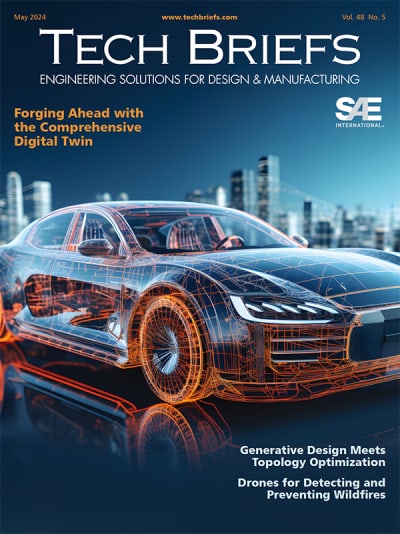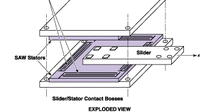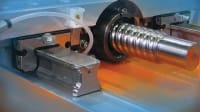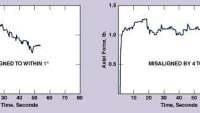A double-parallelogram ("porch swing") carriage mechanism has been devised to provide for free linear motion of one or more retroreflector(s) in a Fourier-transform infrared spectrometer. Mechanisms like this one are particularly well suited for cryogenic high-resolution Fourier transform spectro-meters in which flat mirrors, dihedral mirrors, or corner-cube reflectors are used as retroreflectors. The basic design of this mechanism can also be adapted to a variety of other scanning optical instruments in which linear travel is required.

The mechanism derives linear motion from the rotary motions of coupled arms that are pivoted at their ends. The mechanism offers advantages of compactness and simplicity of implementation, relative to a linear bearing of equal stroke: Pivots are generally smaller and easier to construct than are linear bearings. It is possible to obtain a large displacement from rotation through a small angle by taking advantage of the radius provided by a pivoted arm. The mechanism also includes flexure pivots, which are especially favorable as rotary bearings because they are nearly frictionless and nonlubricated and they work over a wide temperature range.
The mechanism (see figure) includes a first swing in the form of a parallelogram linkage between a base and an intermediate stage. The mechanism also includes a second swing (again, a parallelogram linkage) that suspends a retroreflector stage from the intermediate stage. The arms of the two swings are of equal length and are constrained by a coupling (as described in the next paragraph) to rotate by equal amounts in opposite directions, so that the vertical component of the motion of the first swing is compensated by the matching, opposite vertical component of the motion of the second swing. The net result is that the motion of the retroreflector stage is purely horizontal, as required.
On each side of the intermediate stage, an arm of the first swing is coupled to a neighboring arm of the second swing in the following way: A portion of a wheel is attached to each arm so that the axis of the wheel is centered on the intermediate-stage pivot of the arm. The radii of all four wheels are the same, and are chosen to bring the rims of a pair of wheels into proximity. A pair of flexible bands is placed in the gap between the two wheel rims on each side of the intermediate stage. The two ends of each of these bands are attached to opposing rims. The two adjacent bands are crossed for balance. The bands are put under tension at the end attachments. This combination of bands and proximate wheel rims effects a frictionless, gear-like coupling between the arms of the first and second swings.
In the original spectrometer application, a motor is attached to the carriage to drive the linear motion, and sensors monitor the motion to provide feedback for a motion-control system. The control system can thereby scan the retroreflector stage at a steady rate through the path difference of the interferometer. The carriage mechanism enables nearly frictionless transport for smooth travel over long displacements. It can operate over a wide temperature range. Because of the smallness of frictional forces and of net spring restoring forces involved in its operation, this mechanism imposes only a minimal demand upon a motor drive.
This work was done by David W. Walser and Donald E. Jennings of Goddard Space Flight Center.
GSC-14297





















